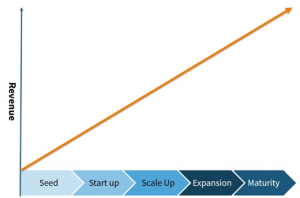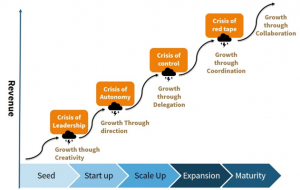AI/ML
Breaking Through Small Business Growth Traps
As entrepreneurs, we put our business model together, with beautiful graphs of growth – either linear or as a curve and look forward to unfettered success. In fact, after the slog of launching a product you may well be enjoying the fruits of that success.

Then reality kicks in. Growth stalls and most often we think it’s due lack of ‘sales’. However, it may be a natural stepping stone in business growth. Virginia Lewis and Neil Churchill outlined 5 common stages of small business growth in a 1983 Harvard Business Review article. They described the crises or growth traps companies typically face as they transition from one stage to the next. Knowing what those typical growth traps are means that you can put in the right personal development, team, culture, processes and focus to break through them.

EXAMPLE: THE CHALLENGE OF LEADERSHIP FOR ONE START-UP
For one organisation we worked with, the entrepreneur had a brilliant idea, and we developed the product and web-site for him, ready for launch. His strengths were networking & relationships and had been successful in the past with such customers. His challenge was wanting to get the ‘perfect’ solution before any customers could use it and struggled to let go of control. This meant that initial sales conversations were good, but growth got trapped due to a fear of delegation. We also found product releases kept on being delayed due to fixing different issues from each sales meeting rather than taking the ‘fail fast’ mindset and adapting based on real use. This business was stuck in the Seed to Start-up growth trap. Break out would come from education of the business leader in agile thinking and coaching in delegation.
OVERCOMING THE GROWTH TRAPS AT EACH STAGE
SEED STAGE
You’re often a couple of colleagues, cash strapped and thinking of a brilliant idea. It’s an exciting creative stage, but also a point of needing support without the funds to pay for it.
GROWTH TRAPS INCLUDE:
- Cashflow, and seed funding – it’s easy to get stuck because of priorities of spend; technology is real money, and time can be seen as free. But surrounding yourself with the right team and advisors can be cheaper in the longer term.
- The resilience for success – Successful solution may start small and be rough around the edges but have a clear vision for growth. In the early 2000s Lego spent millions building a perfect online building experience. It didn’t succeed, and a small start-up called Minecraft succeed where Lego failed.
- Building a Profitability Business Idea – we’ve seen start-ups with the goal of just getting eyeballs on the site, or building a community, without a clear path from market share to revenue. The cost and revenue model are key
- Having a balanced team – The triangle of Sales, Product, Operations with a core customer focus. We often find tech start-ups have a leader with a technology or product mindset and feel obliged to take on the sales role because they are the owner, but it’s not their strength.
- Operational & Financial Rigour – a start-up is filled with possibilities and an entrepreneur often has an initiator mindset, which can lead to back office chaos. Using part time executive director roles can ensure that rigour is put in place from the start, and ready to scale.
- Making the initial sales – Often a few friendly paying customers can be the secret for success and using the knowledge built from one to extend to others.
START-UP
Once the product is launched the importance is to grab the initial sales whilst not running out of cash. Growth comes from having a clear direction for the business and moving from possibilities to realities. It means having the resilience for all the people who say no until breakthrough comes.
GROWTH TRAPS INCLUDE:
- Managing Cash Reserves – This is a real balance of expanding the team and having enough cash to maintain the business as new people learn and become effective
- Managing Sales Expectations – It’s easy to build sales teams and partnerships that become too diffuse and require too much management, stifling sales. A clear go-to-market strategy is required, together with an incentive model that rewards for profitable sales.
- Product Agility – customer feedback is key and it’s important to shape the product based on that feedback without being swamped by all the ideas
- Burnout – the team only has a finite capacity and what was taken up scale-up
SCALE-UP
Congratulations the business is soaring, and the customers are coming in. Growth comes from building the team beyond the founders and delegating successfully, and for the initial team to release other to play to their strengths
GROWTH TRAPS INCLUDE:
- Product Roadmap – what might have been the breakthrough for business now needs to be more than a ‘one hit wonder’. The company value depends on a maturing product process and a product that can clearly move into new areas
- Scaling up Customers – what worked in time and investment in initial customers’ needs to become automated and clear as you widen the team, so nothing falls through the gaps.
- Crisis of Delegation – Lower level managers feel restricted by top-down leadership and top managers do not to give up responsibility. This is time to build better delegation skills
EXPANSION
This is where the business is driving success and just as the leadership needed to learn new skills to launch a business, the shape of the business has changed that there are new skills to be learnt. Often companies hit the buffers here as there is a tidy profit, but it requires investment again to launch to the next size.
GROWTH TRAPS INCLUDE:
- Moving into New Markets – this includes opening new offices and industry areas. Here it’s important to understand the essence of the business and the culture that will be transmitted. Often the culture is lost with acquisition or building virtual teams. Building a playbook / template for each office can accelerate recruitment and delivery.
- Adding New Products/Services – this is where a real innovation strategy comes into play, as competition moves into the market, technology changes, and the team needs to deliver regular improvements that match the shifting market.
- Crisis of Red Tape – As the processes mature, there’s the risk of too much bureaucracy that stifles innovation and agility. Customer focus and an attitude of make it easier for the employee so they make it easier for the customer can reduce this.
- Increasing Market Competition – you’re now visible to competitors, and the need for legal services to protect the business, its intellectual property, and dominant players fighting dirty.
- Resilience for Recession – by the time the company is in expansion the macro economic outlook may have hit the rocks. This is where it is important to have plans around resilience – of customer base, or cost control, and cash reserves to invest through and out of recession.
MATURITY
Maturity often hits when there is a new generation of leaders in the business. They weren’t there with the initial launch and the old guard may look back fondly to the innovative growth of the business. As they say ‘conservatism is the worship of dead revolutions’. This is where it’s important that parts of the business continue with the innovation and start up mentality to be the growth businesses of the future.
This is where the business is driving success and just as the leadership needed to learn new skills to launch a business, the shape of the business has changed that there are new skills to be learnt. Often companies hit the buffers here as there is a tidy profit, but it requires investment again to launch to the next size.
GROWTH TRAPS INCLUDE:
- The Ministry of No – the approval process and management reporting rewards keeping to the status quo and stifling innovation (which equals risk)
- Inward focus – the business stops listening to customers and incentives are driven for internal targets such that teams fight against each other rather than fight together for the customer.
- Seismic changes to the market – for example LED lights mean we don’t change light bulbs – so what do bulb manufacturers do once we’ve replaced them all? Planning for new entrants
- Siloed thinking – teams become so large and distant from customers that knowledge isn’t shared and growth can only come by collaborating and connecting existing ideas in new ways.
WHAT CAN I DO, NOW?
As a business owner, find which stage you are at and see the typical growth traps you may be facing at this stage and the next. You may consider:
- Do I have the right and balanced team, based on skills and personalities?
- What personal development & behaviours do I need to build to leader at the next stage of growth?
- Have I got the right level of maturity in my processes and tools, so the team can focus on delivery and not the process?
- Am I with the right partners/team for innovation, and resilience of my products?
- Am I setting clear direction, delegating and transmitting the culture so that the essence of success continues as the business grows?
- Am I addressing the growth traps, so I make my business attractive for my shareholding and future investors?
ABOUT THE AUTHOR
Peter Bricknell helps businesses break through their growth traps through the link of business, technology and leadership growth. Over the last 20+ years, he has worked across Europe and the USA, from corporates to smaller start-ups shaping out digital programmes, crafting product roadmaps and driving the psychology of change. When not in the office he is cycling the streets of London, scuba diving or dabbling with a paint brush.
Disclaimer: This is a guest post. The author’s views are entirely his or her own, and don’t necessarily reflect the opinions of Innovify.
Website: https://www.alsothus.com



